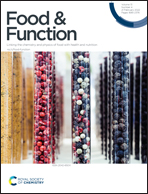Integration of intestinal microbiota and metabonomics to elucidate different alleviation impacts of non-saponification and saponification astaxanthin pre-treatment on paracetamol-induced oxidative stress in rats†
Abstract
Intestinal microbiota and metabonomics were integrated to investigate the efficiency of non-saponification or saponification astaxanthin (N-Asta or S-Asta) derived from Penaeus sinensis by-products on alleviating paracetamol (PCM)-induced oxidative stress. Pre-treatment with N-Asta or S-Asta for 14 days restored the cellular morphology of the intestine and increased glutathione (GSH) levels under PCM overdose in rats. However, S-Asta displayed higher adsorption than that of N-Asta. PCM overdose reduced the richness and diversity of intestinal microbiota in the model group. Comparably, N-Asta or S-Asta pre-treatment increased the Actinobacteria abundance. Increased phyla Bacteroidetes and Verrucomicrobia were only found in the S-Asta-pre-treated group. At the genus level, N-Asta pre-treatment increased Lactobacillus and Parasutterella abundance, whereas S-Asta pre-treatment elevated Bacteroidales_S24-7_group_norank and Ruminococcaceae_uncultured. Compared to the control and model groups, remarkable increases of fecal short-chain fatty acids were detected in both N-Asta and S-Asta pre-treatment groups, suggesting the contribution of N-Asta and S-Asta adsorption to SCFA-producing bacteria enrichment. Furthermore, the genera of Ruminococcaceae_uncultured, Ruminiclostridium_9, Ruminococcaceae_unclassified and Ruminococcus_1 showed high correlations with propionic acid, isobutyric acid, butyric acid, isovaleric acid and valeric acid increases in the S-Asta pre-treated group. Seventeen plasma biomarker metabolites in more than 10 metabolic pathways were responsible for the difference between the N-Asta and S-Asta pre-treated groups. Metabolites GSH, retinol, all-trans-Retinoic acid and taurine related to antioxidant activities were significantly accumulated in the S-Asta pre-treated group, while increasing taurocholic acid levels associated with the anti-inflammatory activity was found in the N-Asta-pre-treated group. Therefore, N-Asta and S-Asta could have potential applications in counterbalancing intestinal flora and metabolite disturbances by overdose chemical induction.



 Please wait while we load your content...
Please wait while we load your content...